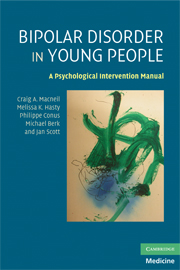Book contents
- Frontmatter
- Contents
- Preface
- Acknowledgements
- Introduction
- 1 Bipolar disorder
- 2 Assessment and engagement
- 3 Insight, adaptation, and functional recovery
- 4 Medication adherence
- 5 Cognitive behavioral therapy interventions
- 6 Social rhythm regulation
- 7 Relationship issues and family work
- 8 Alcohol, substance abuse, and other comorbid disorders
- 9 Identifying early warning signs, preventing relapse, and termination of therapy
- Appendices
- References
- Index
6 - Social rhythm regulation
Published online by Cambridge University Press: 06 July 2010
- Frontmatter
- Contents
- Preface
- Acknowledgements
- Introduction
- 1 Bipolar disorder
- 2 Assessment and engagement
- 3 Insight, adaptation, and functional recovery
- 4 Medication adherence
- 5 Cognitive behavioral therapy interventions
- 6 Social rhythm regulation
- 7 Relationship issues and family work
- 8 Alcohol, substance abuse, and other comorbid disorders
- 9 Identifying early warning signs, preventing relapse, and termination of therapy
- Appendices
- References
- Index
Summary
There is a time for many words, and there is a time for sleep.
Homer, The Odyssey (2007, p. 135)As discussed in Chapter 1, for many young people, exacerbation of manic or depressive symptoms occurs through a spiral of contributing factors, both biological and psychosocial. Specifically, a young person may have an underlying biological or cognitive vulnerability to bipolar disorder, which results in the reduced effectiveness of the person's “shock absorbers” for significant events. Therefore, when a significant event occurs, he/she may experience more marked cognitive, behavioral, or affective change than would someone without the disorder. Following this, he/she may experience either decreased social or occupational functioning or social withdrawal leading to depression, or increased activity and sleep disruption resulting in mania. These changes may in turn exacerbate the initial mood state, and lead to a cycle towards more marked symptomatology (see Figure 6.1).
Sensitivity to circadian rhythm changes is a key vulnerability factor for people with bipolar disorder (Goodwin & Jamison, 1990). Sleep disruption in particular, which can be caused by substance misuse, medication non-adherence, family tensions (high levels of expressed emotion), loss of regular routines because of long-haul travel (crossing time zones) (Scott, 2003), physical illness, study, or other schedule changes, appears an important trigger for mood disruption. Indeed, Wehr et al. (1987) suggested that reduction in sleep may be the “final common pathway” (p. 201) between the initial occurrence of a life event and the development of manic symptoms.
- Type
- Chapter
- Information
- Bipolar Disorder in Young PeopleA Psychological Intervention Manual, pp. 98 - 104Publisher: Cambridge University PressPrint publication year: 2009

